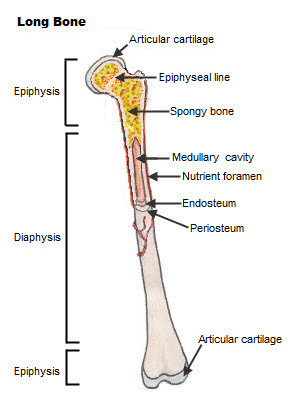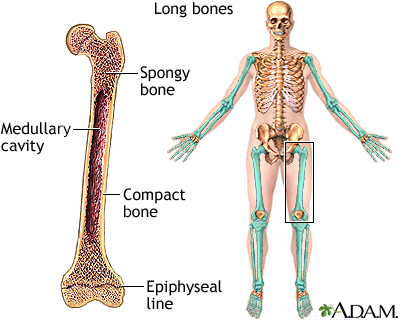Red marrow is composed of stem cells B. What term below describes the shaft of the long bone.

6 3 Bone Structure Anatomy Physiology
Long bones are found in the arms humerus ulna radius and legs femur tibia fibula as well as in the fingers metacarpals phalanges and toes metatarsals phalanges.

. Red marrow fills the spaces in the spongy bone. Keep in mind however that the term describes the shape of a bone not its size. The outside of the flat bone consists of a layer of connective tissue called the periosteum.
Long bones function as levers. They grow primarily by elongation of the diaphysis with an epiphysis at each end of the growing bone. Wide end of a long bone which is covered with articular cartilage and is composed of cancellous bone.
Long bones function as levers. The body or shaft of a long bone such as the femur or the humerus is called the diaphysis. Long bones are found in the arms humerus ulna radius and legs femur tibia fibula as well as in the fingers metacarpals phalanges and toes metatarsals phalanges.
When a human finishes growing these parts fuse together. Keep in mind however that the term describes the shape of a bone not its size. Parts of a Long Bone.
Structurally a tarsal is a short bone meaning its length width and thickness are about equal while a metatarsal is a long bone whose length is greater than its width. The diaphysis the ends are called the epiphysis the space in between those is the metaphysis epiphyseal plates are where growth in length occur they fuse to become epiphyseal lines. Red marrow is found in the cavity of long bones.
Each type of bone serves a particular purpose and some types have more than one function. Region between the epiphyses. The wider section at each end of the bone is called the epiphysis plural epiphyses which is filled internally with spongy bone another type of osseous tissue.
Some bones in the fingers are classified as long bones even though they are short in length. The long bones are those that are longer than they are wide. The space inside the diaphysis-.
Term means the surgical placement of an artificial joint. Each epiphysis meets the diaphysis at the metaphysis the narrow area that contains the epiphyseal plate growth plate a layer of hyaline transparent cartilage in a growing bone. Red bone marrow fills the spaces between the spongy bone in some long bones.
Functionally the tarsal provides limited motion while the metatarsal acts as a rigid bar against which muscle can act. Red marrow fills the spaces in the spongy bone. Ends of long bone farthest away from the point of attachment.
Long bones are one of the five bone types that are classified by shape. The epiphyseal line is a remnant of an area that contained hyaline cartilage that grew during childhood to lengthen. Long bones are hard dense bones that provide strength structure and mobility.
A long bone has a shaft and two ends. The head of a bone usually refers to the distal end of the bone. Long bones especially the femur and tibia are subjected to most of the load during daily activities and they are crucial for skeletal mobility.
A long bone is a bone that has a shaft and 2 ends and is longer than it is wide. Long bones are those that are longer than they are wide. Ends of a long bone closest to a point of attachment.
Long bones include the humerus upper arm radius forearm ulna forearm femur thigh fibula thin bone of the lower leg tibia shin bone phalanges digital bones in the hands and feet metacarpals long bones within the hand and metatarsals long bones within the feet. The shaft refers to the elongated sections of long bone and the neck the segment between the head and shaft or body. The shaft of a long bone is called.
This section of the bone is generally wider than the rest of the bone. The wider section at each end of the bone is called the epiphysis plural epiphyses which is filled with spongy bone. A long bone is one that is cylindrical in shape being longer than it is wide.
This term refers to the end of a long bone. The thigh bone femur is a long bone. Bones are commonly described with the terms head neck shaft body and base.
The end of the long bone is the epiphysis and the shaft is the diaphysis. Long short flat and irregular. All 206 of the bones of the skeleton can be categorized into four types.
This is due to the shape of the bones not their size. The wider section at each end of the bone is called the epiphysis plural epiphyses which is filled with spongy bone. A bone that is not longer than it is wide.
Term describes a fracture in which the bone is splintered or crusched. The end of the long bone opposite to the head is known as the base. They are one of five types of bones.
Term means an opening in a bone through which blood vessels nerves and ligaments pass. Term describes the wide end of the long bone. Each epiphysis meets the diaphysis at the metaphysis the narrow area that contains the epiphyseal plate growth plate a layer of hyaline transparent cartilage in a growing bone.
Long short flat irregular and sesamoid. A long bone is one that is cylindrical in shape being longer than it is wide. Long bones have a thick outside layer of compact bone and an inner medullary cavity containing bone marrow.
The ends of a long bone contain spongy bone and an epiphyseal line. The end of the long bone is called. It provides the foundation to which other structures cling and helps to create our shape.
Which statement about red bone marrow is false. Ledwell Getty Images.

Seer Training Classification Of Bones

6 3a Gross Anatomy Medicine Libretexts


0 Comments